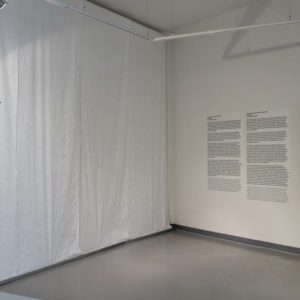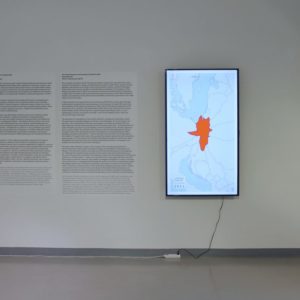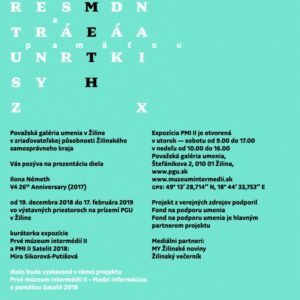Ilona N├ęmeth – V4 26th ANNIVERSARY, 2017
The computer animation V4 26th Anniversary shows section of a map where the states Poland, Czech Republic, Hungary and Slovakia are located. In 1991, these countries (Czech Republic and Slovakia as one state at the time) formed an alliance named V3 (Visegrad Three) which later became V4 after Czechoslovakia was divided. The foundation of this alliance was defined by an effort to cooperate in the process of the European integration. In 2004, after the states entered the European Union, the mission of this alliance defined itself as concentrating on the enforcement of stability and mutual cooperation in the wider region of Central Europe.
In this animation, the map of this section of Europe with the V4 countries goes through a deformation powered by the years passing on a chronoscope. It counts the years since the foundation of the alliance until the year 2026, when the V4 should celebrate the 35th anniversary of it’s existence. The deformation of the map, at the end of which the areas of the member states of V4 shrink into a small red spot resembling a drain, or more expressively, a rectum, also works reversibly ÔÇô back to the imaginary start, where we can see the map in real scale. Manipulation of the map encourages us to realize the gradual diversion from solidarity, mutual understanding and from tolerating otherness ÔÇô something that not only in Slovakia, but also in our surrounding countries becomes more and more apparent since as early as 1990. The animation also references the fact that although the Central European states went through the process of integration to Europe (during the 1990’s Slovakia intensively endorsed this ÔÇô mainly referring to the fact that it is located right in the middle of Europe), at the same time, gravitations towards nationalism and xenophobia grow stronger. As if the states of V4 created a fairly distorted reflection of the pact about friendship and cooperation that was actually established by Charles I. of Hungary, John of Bohemia and Casimir III. the Great in Visegrad.
The animation works with the problematics of historical memory in a similar manner ÔÇô it does not only point to the recent past, but also to the fact how memory and social construct may weaken or disappear altogether. It is also a merciless vision of the future: it metaphorically (through the motive of a rectum or drain) shows where the gradual elimination of solidarity, cooperation and respect in politics and society gets, and it is therefore a representation of how noble ideals disappear, become small or useless. In connection to the current events surrounding the Marrakesh Political Declaration on migration in Slovakia and the surrounding states, this animation showing the devaluation of ideas of cooperation and pro-European thought gains a more intensive current reference.
A symbolic pendant of this piece are works by the artist dedicated to the problematic of thinking in local contexts as opposed to the global reality ÔÇô an aspect also present in the V4 26th Anniversary. A contribution to the project Donaumonarchy (2006), the billboard Midpoint of Europe that shows nine centres of the continent with notes on when were they designated is the artist’s ironic commentary of the states’ attempts to make/own the geographical middle of our continent, which can be considered an act of local nationalism. An example is placing a stone as a symbolic centre of Europe in Kremnick├ę Bane in 1992, just before the founding of sovereign Slovakia, or proclamation of Nazis that based on measuring the centre in Dresden in 1900, the Third Reich is the heart of Europe with an entitlement to rule the others. Based on these motivations, the justness to dispose of the Midpoint of Europe is questionable, and contrary to the scientific methods which aren’t able to specify. Since 2009, Ilona N├ęmeth is in the process of making an open work with the same title, where she shows political and nationalist backgrounds of these attempts by commenting through creating her own signs designating the Midpoint of Europe, and placing them in her chosen locations (Rome, Brooklyn, Moscow). The line of reasoning that in the current map of the European Union, especially in the states of Central Europe, ideas of mutual cooperation and respect prevail, but at the same time, nationalist tendencies leading to gradual isolation of these states occur is a common denominator for the animation as well as for these works.
Ilona N├ęmeth (*1963) entered the art scene at the beginning of 1990’s with installations and site-specific works. The object Column (1995) is exhibited in the PMI II. The site-specific citation of a column is also a memory repository ÔÇô the cumulation of hair inside refers to the privacy and identity of unknown individuals. Starting roughly during the arrival of the new millennium, a strong engagement feature has been apparent in her work. She uses her pieces to comment on current affairs in the society ÔÇô they touch upon power, media manipulation, intolerance of minorities, and generally show a legible sociological dimension. The outreach of her work is strongly supported by its exhibition in the public space. Her current work is also defined by concentrating on contexts (social, historical) of the environment in which they are shown and the application of the artist’s individual experience from the given location.
Exhibition is supported using public funding by Slovak Arts Council




